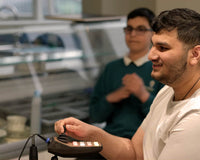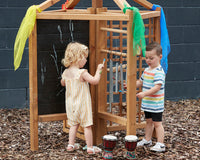What are the parts of a violin?

- The scroll; thought to be merely ornamental, they can serve to hook the violin when it is not being played. Below the scroll are 4 pegs in the pegbox. These are used to wind the strings and hold them in tune which simply fit into the holes and are gently pushed into place.
- Attaching the scroll and pegbox to the body of the violin is the neck, with the fingerboard on the top. The sound box is the main body of a violin, and is the ‘belly’ of the instrument as it is the source of the rich, pleasing sounds made when it is played.
- Woods like spruce and maple are often used and inside are a series of arches that bind and reinforce the body. The f-holes on either side of the bridge emit the sound of the violin from out of the sound box. In between the f-holes is the bridge which acts to raise, support, and hold the strings in place. It also spaces them apart.
- Bridges are not glued into place, and the first few times you string a violin, you will learn that there are techniques to get the bridge in place as the strings are tuned. From the bottom, the tailpiece is mounted which is where the strings are anchored. Most violins feature 4 fine tuners on the tailpiece.
- Lastly, the chin rest is the cup-like plate mounted on the bottom, front-facing side of the sound box. Some models also have a shoulder rest but they are not required, although a chin rest is standard.
How old do I have to be to play the violin?
- Children as young as 3 can learn the violin. Violins come in different sizes to accommodate children as they grow.
- The smallest look like toys, but despite their cuteness they work as well as a full-size violin!
- A 6-year-old will generally start on a ¼ size violin, and as they grown work through the sizes to ½, ¾ and then full size. See the next question for which sized violin you will need.
What size violin do I need?
- There are about 9 different sizes of violins for players from one-year old to adult. It is not so much the child’s age as it is the length of his or her arms.
- Best bet is to consult with the instructor because some have opinions—in addition to a lot of experience—as to what size violin to start with.

Can I learn the violin on an electric violin?
- Electric violins are usually aimed at musicians who perform and need amplification. They are used by musicians who already play acoustic violins and will be for a specific genre of music.
- They aren’t used for teaching generally. However, if you have a passion for learning an electric violin you can of course do this!
- In the same way that you would learn an electric guitar. It can also be useful if you need to turn the volume down when practising – you can plug in headphones and no one else can year you!
What accessories do I need for my violin?
- Your violin ideally needs to be in a case, with a chin rest attached, a separate shoulder rest, a bow and some rosin.
- With all this in place you have everything you need to play the violin.
What notes are the strings on my violin?
- The strings on a violin are G, D, A and E.
- E is the highest pitch string, and the thinnest and G is the lowest pitch and thickest string.
- They need to be strung in the correct order and put on by someone who knows what they are doing.
- The strings will go out of tune frequently and you will learn how to tune the violin either by the pegs at the top or the fine tuners at the bottom of the violin.
When should I put new strings on my violin?
- Over time strings will break. This is the same as any string instrument – there just aren’t strings that last forever.
- Quite often they will wear thin and then snap, or sometimes when tuning strings can snap.
- You will need to take the broken string off and put a new one on. You don’t always need to replace the whole set.
- If strings are getting worn and you have an event or exam coming up you may want to change the whole set, although this isn’t advisable immediately before needing to play on brand new strings – they can take a little work to wear them in a little.
How do I know what strings to put on my violin?
- It is a good idea to use quality, branded strings.
- When you are a beginner there is no need to spend a huge amount on professional strings, but a decent branded set in the middle of the price range on offer will last longer, sound better and be easier to play.
How do I learn how to tune my violin?
- Tuning a violin is tricky in the early days. The tuning is a skill that you will learn over time.
- Initially it is a good idea to let the teacher tune and you will learn by watching.
- Most beginner violins will have fine tuners at the bottom of the instrument, and this is far better to learn how to use than the pegs.
- The pegs take some skill to know how to turn them without snapping the strings or releasing them all together. It is like turning a spring when you first experience this!
How do I keep my violin from falling out of tune?
- First, properly stringing the instrument is important. Perhaps bring it into a store or find a friend who knows how it is done the right way.
- Watch them and learn; there are little tricks to stringing violins, dealing with the unglued bridge, and getting the pegs set into place firmly.
- The peg, by far, is the most important element. The tapered effect of the peg, which is narrow at one end and grows gradually fatter, is what keeps strings in tune.
- Humidity can affect the pegs and the scroll, because wood reacts to humidity. That alone can “untune” the violin. So, learning to wedge the pegs more and more firmly into the holes, as the tuning reaches the right pitch, is the art of tuning.
Why do I need rosin for a violin bow?
- Without rosin, your bow will just glide across the strings and not produce a sound. The rosin gives resistance on the bow which in turn produces the sound from the strings.
- Rosin is a resin that comes from pines or plants. You will need to rosin your bow every time you play the violin. It forms a fine powder when it is pulled across the strings and will often leave a small white residue on the violin after playing.
- This ideally needs wiping off to stop it building up and forming a sticky mess on the wood.
What is a good violin for beginners?
- Without doubt, one of the best value for money violins money can buy is the Forenza Prima 2.
- Stunning build, quality and tone, solid woods such as ebony, and all very affordable. They are also available in all sizes, so you don't have to break the bank.
Can I play the violin left handed?
- The simple answer is no. Well you can, but generally the violin is taught on the right, but it is possible to play left handed. You will just need to make sure that your teacher can cope with this, but often they will have come across it before!
- Just think about playing in an orchestra with 40 other violinists, all right-handed? If you played left-handed, your bow would be constantly crashing into your colleagues = musical carnage!
What is the best way to hold a violin?
For the left, or playing hand:
- You elbow remains under the centre of the violin.
- Your wrist is gently rounded.
- Avoid resting your wrist on the neck of the violin.
- Your thumb is kept opposite the first or second finger.
- Create a curved, backwards C-shape in the open space between the thumb and index finger.
How much should I practice?
- The great Leopold Auer was once asked this question. Auer responded: “Practice with your fingers and you need all day. Practice with your mind and you will do as much in 1-1/2 hours.”
- Many will tell you that practicing more than 4 hours in any one day means you’re not doing it right—and you need to let the mind and body rest, to assess what worked and what did not, and to let muscle memory take root.
- Personally, any constructive practise is better than none!
How long will it take for the violin to sound nice when I play it?
- Quicker than Bag Pipes!! The million-dollar question! If you take well to the violin, have a natural ability and good ear, it will always sound good!
- If, however, you are more average, and must learn where to put your fingers on the fingerboard to accurately get each note and learn to hear your own intonation then it will take longer.
- The violin isn’t easy to make sound nice in the early days, but this goes for many instruments and is all part of the journey. Once you start learning more notes and having a wider repertoire your violin will sound better day after day. It is all about practice and perseverance.
Can I teach myself the violin?
- Yes, you can! There are many tutor books for learning the violin, and on-line tutorials. If you have the confidence, or just want to see how you get on, there is no harm in teaching yourself at all.
- Many musicians have started out this way, and teachers can step in if needed as a one off, or occasional guidance on what you are doing.
What is the hair on the violin bow made from?
- Traditionally, the hair on a violin bow is hair from a horses’ tail. There will typically be between 150 and 200 hairs. When you are playing, hairs will come loose now and again, and these just need pulling off.
- Once the hair is getting a bit thin, you can replace this with a new set, or with the release of the excellent Forenza Bows, simply purchase a new one!
- Equally, if too much rosin is used, the hair can become lumpy and sticky and will need professional cleaning.
Why is the hair slack on my violin bow?
- When the bow isn’t in use, the hair should be slackened by loosening the hair using the end screw.
- This stops the hair from stretching and gives it a chance to relax between playing.
- When the bow is in use the hair will need tightening up using the end screw. It doesn’t need to be super tight – just enough to be firm to the touch.
Why does my violin 'scrape' and sound horrible when I play it?
- This can be for several reasons. There may be too much, or not enough rosin on the bow; the bow can be too tight, or not tight enough; your fingers are catching other strings as you are placing them; your strings may be getting worn or the violin is just not set up properly. Or, you need to practice more and have lessons!!
How should I clean my violin and the bow?
- Your violin will appreciate some TLC. Give it a wipe after each time you play and take off the excess rosin and greasy finger marks.
- Just using a clean duster will do this. The rosin hair should be loosened, and the bow can be wiped down using a separate cloth to remove excess rosin.
- Your violin and the bow should be stored in the case between uses and fastened in to keep it safe.
- Many professional players cover their violins in the case with a separate cloth – often a fine fabric as a gentle blanket just to keep it from being exposed to any fluff or dirt from the case.




















